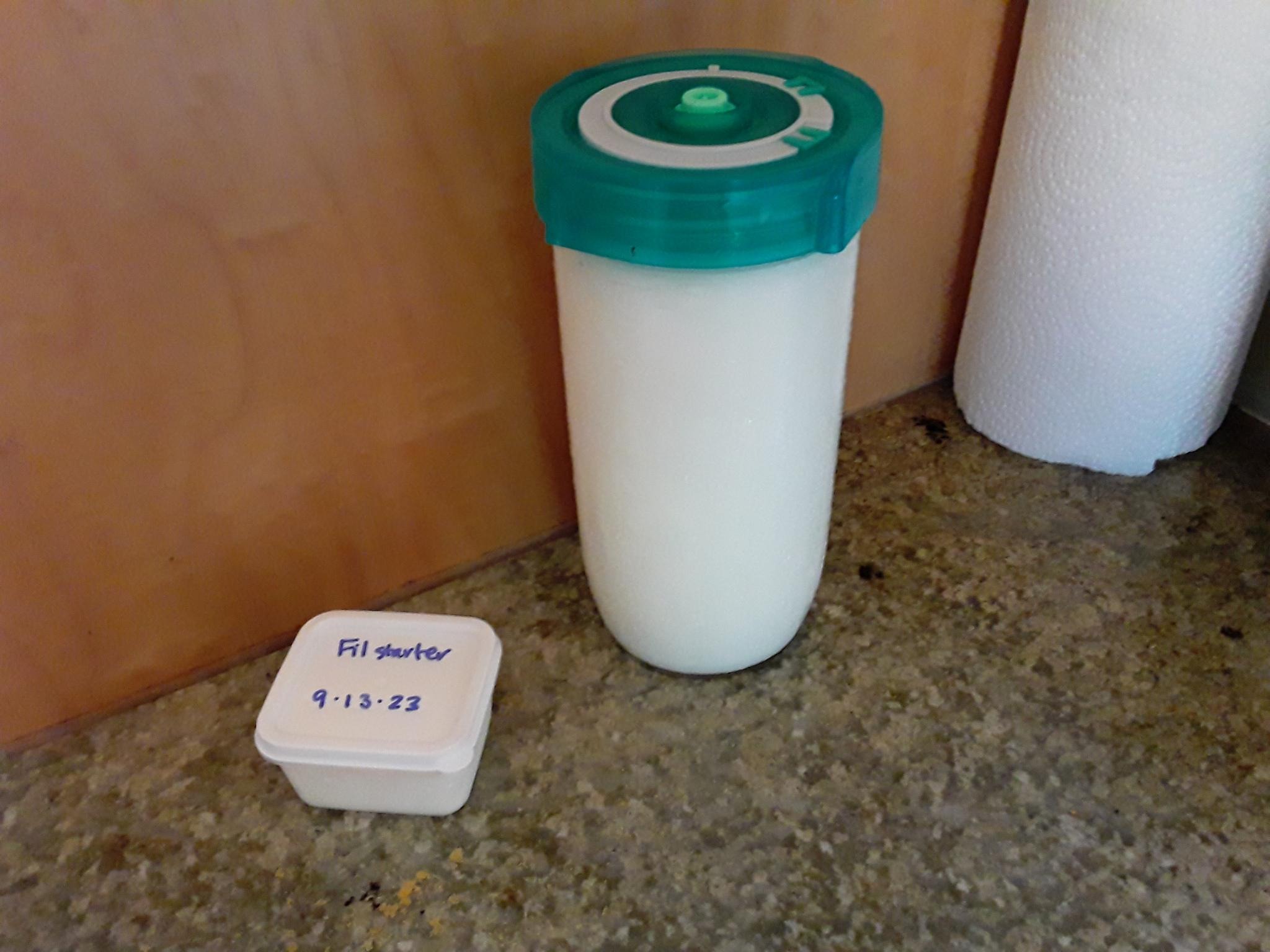There is a lot to love about Sweden. A wholesome vitality, elegant practicality, and respect for tradition can be seen in the landscape, the people, and their products — not the least of which is filmjölk. This fermented food dates back to Viking times or earlier, and has continued to provide delicious cultured dairy for generations of Swedes.
What is filmjölk?
Unique to Sweden, filmjölk is a yogurt-like product that is drinkable, mild-flavored, and incredibly easy to make. It has health benefits similar to yogurt, but some pleasantly surprising differences as well.
How healthy is filmjölk?
Like other microbial ferments, filmjölk contains short chain fatty acids (SCFA) beneficial to our digestive system and has a lower glycemic index than milk. The fermentation process also improves the availability of vitamins in milk, essentially making it more nutritious.
Although it is not a probiotic powerhouse like kefir — which boasts dozens of different species of probiotic yeasts and bacteria — the few strains that ferment filmjölk are nothing to sneeze at.
Lactococcus lactis is a bacterium used in the production of cheese and buttermilk. The Lactococcus lactis subsp. cremoris present in filmjölk is highly efficient at transforming the lactose and galactose in milk, making filmjölk even more digestible than yogurt for those with lactose intolerance.
Success
You are now signed up for our newsletter
Success
Check your email to complete sign up
While its probiotic properties have not been thoroughly researched, this bacterium has been shown to boost immunity; may improve skin conditions, allergies and IBD; and is being researched for its ability to inhibit the growth of various cancer cells.
Leuconostoc mesenteroides cremoris is another beneficial bacterium that exhibits both prebiotic and probiotic properties. It is the same species responsible for fermenting vegetables like pickles and sauerkraut, and part of what makes filmjölk so special.
Characteristics of filmjölk

Like Lactococcus lactis, Leuconostoc mesenteroides is a mesophilic microorganism, which works at cool temperatures. Thus, unlike yogurt, filmjölk is made at room temperature – there is no need to heat milk and maintain warmth for the culture to grow. Glorious simplicity!
Culturing milk lowers its pH considerably. The resulting acidity provides both antimicrobial properties and a characteristic sour flavor; but mesophilic cultures have a different flavor profile than their thermophilic siblings.
Due to the compound diacetyl produced through citrate metabolism, filmjölk has a rich, buttery flavor that dominates the sourness frequently found in fermented products. Yet it still has the benefits of a low pH (around 4.3 compared with around 6.3 of fresh milk).
While filmjölk cultures can form curds with extended fermenting times, the process is generally halted through refrigeration after the milk has become thick, but still pourable.
Vikings and filmjölk

Although there is precious little recorded history about the origins of filmjölk, we know that it was around in the Viking Era. Contrary to their common — and not incorrect — portrayal as seafaring conquerors, the vast majority of Vikings were farmers. Cattle and oxen were important livestock in the cool, Nordic lands — providing meat, labor, durable leather and copious amounts of milk.
Traditionally, milk was a seasonal product — available only for several months after cows calved in the spring. Along with cheeses, filmjölk was a way to preserve milk without refrigeration.
Just like early people inhabiting warmer climates discovered yogurt, Vikings took advantage of beneficial bacteria naturally present in the air to culture dairy and prevent spoilage from harmful bacteria. Of course, relying on chance was not foolproof; so the practice of “backslopping” — adding a bit of successful culture to fresh milk — emerged, ensuring a similar, if not identical, product.
Filmjölk today

As production facilities became more advanced, and safety regulations became more strict, filmjölk undoubtedly grew less diverse and more consistent. Arla, a dairy cooperative at the time, was the first to market filmjölk commercially in 1931.
In 1997 Arla, now the leading dairy producer in Scandinavia, introduced the first fruit-flavored filmjölk — strawberry. Owing to its popularity, other flavors followed, and today approximately one third of the filmjölk consumed in Sweden is flavored.
With its mild flavor and creamy consistency, filmjölk can be enjoyed plain as a beverage, consumed with berries and breakfast cereals, or as a companion to knäckebröd — a cracker-like staple in many Swedish households. It is also amenable to smoothies, dips, and various cooked recipes.
Enjoying filmjölk outside of Sweden

While a visit to Sweden is certainly recommended, you don’t have to go that far to enjoy filmjölk. Although it is not yet widely available in the US, you might find it at health-food groceries or Nordic specialty shops. If all else fails, you can definitely find a filmjölk starter culture online.
Either way, you will only need to do the search and purchase once; because after you get your hands on some quality culture, you can make an endless supply of filmjölk.
Making your own filmjölk
If you ordered your starter online, it may come in the form of a dry powder. You should follow the directions to get it going, which will involve some time for both rehydrating and culturing.
Once you have an active culture, the process is as simple as backslopping from the Viking days. Pour fresh milk into a clean jar, along with a couple tablespoons of your ready-made filmjölk. Stir well with a clean utensil, and cover loosely — using either a clean tea towel secured with a rubber band, or a fermentation lid that allows for the release of gasses.
Place the jar someplace out of direct sunlight, where the temperature stays within the range of 68 to 78°F. In about 24 hours it should become thick and creamy. At higher temperatures, the fermentation will take place more quickly, while lower temperatures will slow the process. Check on your milk now and then to see how it’s doing.

Once your filmjölk has reached the desired consistency, cover the jar with a proper lid and refrigerate to stop the fermentation. If it overferments and curdles, don’t worry. As long as it doesn’t have a foul taste, it should be fine to use and will even make a good starter — just reduce the time for the next batch.
Keeping the tradition of filmjölk alive
Consume your filmjölk within a few weeks, and be sure to start a fresh batch before it disappears. In case of a failure (which can happen if your milk is not fresh to begin with), or if you intend to be away for extended periods, ensure that you always have a good backup. Share your culture with friends who will enjoy keeping it alive, or freeze a small amount in a labeled container. Either of these can serve as a starter.
Alternatively, you can preserve your culture by saturating some small pieces of organic cotton cloth with fresh filmjölk and allowing them to dry at room temperature. Be sure to protect the material from fruit flies, which will be attracted to the fermented milk. These dehydrated patches should be stored in a loosely covered jar. To use them, drop one in a small container of fresh milk and give it a couple of hours to rehydrate. Shake well, discard the cloth, and within a day you should have an active starter culture restored.















